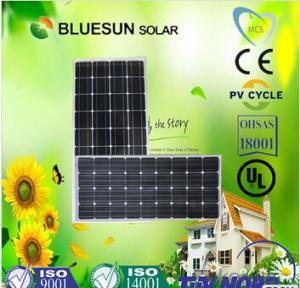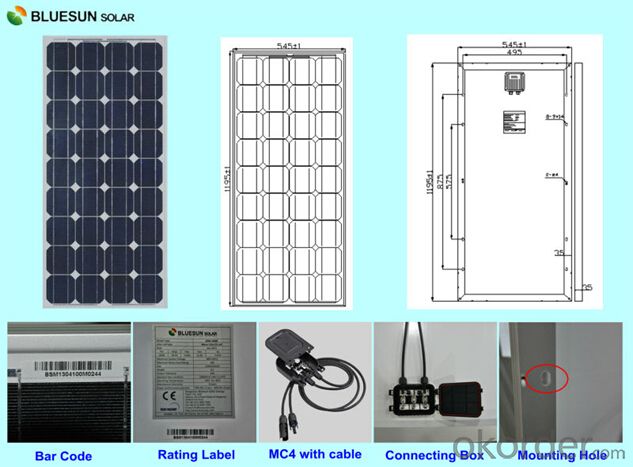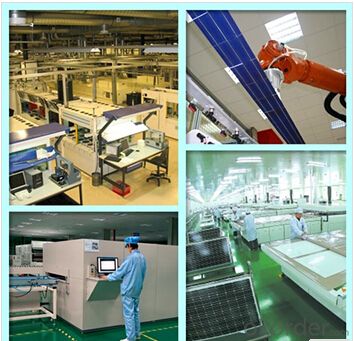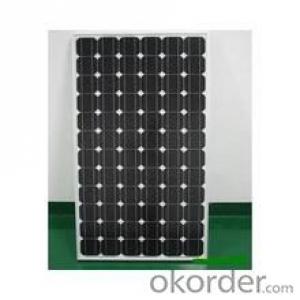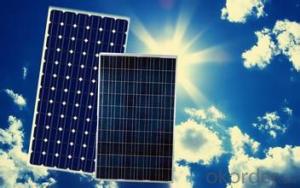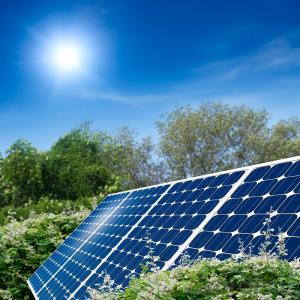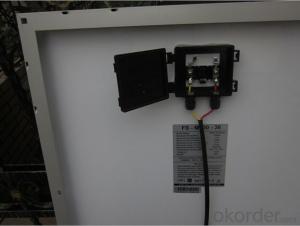100 Watt Monocrystalline Silicon Solar Panels for Metal Roof
- Loading Port:
- Shanghai
- Payment Terms:
- TT or LC
- Min Order Qty:
- 1000 watt
- Supply Capability:
- 3000000 watt/month
OKorder Service Pledge
OKorder Financial Service
You Might Also Like
1. Main Features of Monocrystalline Silicon Solar Modules 100Watt Description
Specifications
broken solar panel for sale
1.Power 100Wp
2.A grade solar Cell
3.25 years Warranty
4.CE/TUV/UL
Quality and Safety
1. Rigorous quality control meets the highest international standards.
2. High-transmissivity low-iron tempered glass, strong aluminium frame.
3. Using UV-resistant silicon.
4. IS09001/14001/CE/TUV/UL
Features
1. Aesthetic appearance with excellent efficiency based on innovative photovoltaic technologies.
2. Strong frame, passing mechanical load test of 5400Pa, instead of the normal.
Warranties
1. 10 years limited product warranty
2. 15 years at 90% of the minimal rated power output
3. 25 years at 80% of the minimal rated power output
2. Detail picture of Monocrystalline Silicon Solar Modules 100Watt

3. Monocrystalline Silicon Solar Modules 100Watt Specification
ITEM NO. | Mono 125*125 cell, 36pcs. Power 100W | |||||
Maximum Power(W) | 100 | |||||
Optimum Power Voltage(Vmp) | 18.06 | |||||
Optimum Operatige Current(Imp) | 5.59 | |||||
Open Circuit Voltage(Voc) | 22.45 | |||||
Short Circuit Current(Isc) | 5.84 | |||||
Solar Cell: | 125*125 Mono | |||||
Number of Cell(pcs) | 4*9 | |||||
Brand Name of Solar Cells | JA Cell, Bluesun Cell | |||||
Size of Module(mm) | 1195*545*35 | |||||
Cable & Connector Type | Pass the TUV Certificate | |||||
Frame(Material Corners,etc.) | Aluminium-alloy | |||||
Back Sheet | TPT | |||||
Cell Efficiency for 100W(%) | 15.8% | |||||
Weight Per Piece(KG) | 8.8KG | |||||
FF (%) | 70-76% | |||||
Junction Box Type | Pass the TUV Certificate | |||||
Tolerance Wattage(e.g.+/-5%) | 0~3% | |||||
Front Glass Thikness(mm) | 3.2 | |||||
Temperature Coefficients of Isc(%) | +0.04 | |||||
Temperature Coefficients of Voc(%) | -0.38 | |||||
Temperature Coefficients of Pm(%) | -0.47 | |||||
Temperature Coefficients of Im(%) | +0.04 | |||||
Temperature Coefficients of Vm(%) | -0.38 | |||||
Temperature Range | -40°C to +85°C | |||||
Surface Maximum Load Capacity | 2400Pa | |||||
Allowable Hail Load | 23m/s ,7.53g | |||||
By pass Diode Rating(A) | 12 | |||||
Warranty | 100% of 10 years, 80% of 25 years. | |||||
Standard Test Conditions | AM1.5 1000W/m² 25 +/-2°C | |||||
Packing | carton or pallet | |||||
1*20' | 25 Pallets / 650pcs | |||||
1*40'STD | 50 Pallets / 1300pcs | |||||
4. Standard production line of Bluesun Factory


5. Packaging & Shipping of Monocrystalline Silicon Solar Modules 100Watt
Packaging
** Normally packing: 1pc/2pcs/3pcs/10pcs/25pcs per carton
** Individual packing requirement is acceptable.
Shipping
By Sea | Delivery from Shanghai or Ningbo seaport |
| By Air | Departure from Shanghai Pudong Airport |
| By Express | Post by DHL, EMS, UPS, TNT. |
6. Certificate of Monocrystalline silicon Solar Modules 100Watt
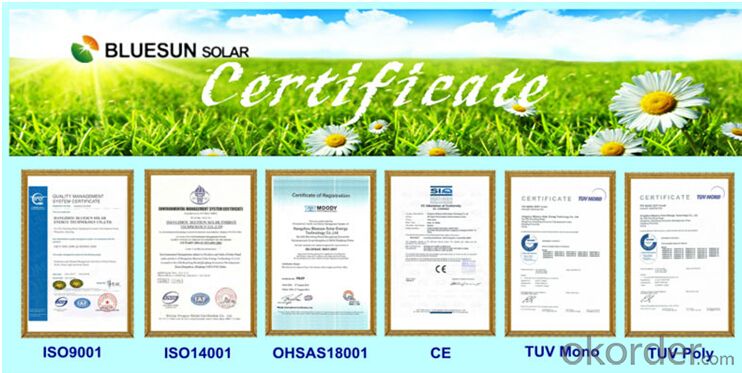
- Q: What is the difference b/w them which one is better .
- these solar panels are named different based on the solar cells used... mono-crystalline solar cells: As the name suggests, each cell is made from a slice of a silicon crystal, which is made by purifying, melting and freezing silicon. pol-crystalline solar cells: these are a slight variation of single crystal solar cells. they are made of slices cut out of blocks of several silicon crystals, as opposed to single silicon crystals. check the link below to see other differences between the two types (easy to understand), such as their prices and efficiency levels. there is also a third type of solar cell/panel called amorphous solar cells.
- Q: My house is aligned exactly North-South, so I have no roof facing South. Is it worth installing solar panels? Are there any good options for dealing with this situation?
- The trouble is that it is so expensive to have installed and as you say it will take many years before you actually start saving above what the installation cost was, I personally would not go ahead and make that sort of investment, it would be more profitable to keep the money in a building society, get the interest from it and use that to pay for your electricity but the main thing that I have against solar Panels is that unless you stay in that house for at least twenty five years you will not reach the point where you are saving and to capitalise on it you would have to stay there for many years more, so you will not have the option of moving house without losing your investment and at the moment having solar panels does not increase the value of the property, it is just a good selling point, when you buy your new house, you would probably have to start all over again and then because of the years will never live long enough to reap any benefit from it.
- Q: What are the benefits of using solar panels?
- There are several benefits of using solar panels. Firstly, solar panels generate renewable and clean energy by harnessing the power of the sun, reducing our dependence on fossil fuels and reducing greenhouse gas emissions. Additionally, solar panels can help to save money on electricity bills, as they generate free electricity once installed. They also require minimal maintenance and have a long lifespan, providing a reliable source of energy for years to come. Moreover, solar panels can increase the value of a property and contribute to energy independence, especially in remote or off-grid areas. Overall, the use of solar panels promotes sustainability, cost savings, and a cleaner environment.
- Q: Are there government incentives for installing solar panels?
- Yes, there are indeed government incentives available for installing solar panels. These incentives can vary depending on the country and region, but they often include tax credits, grants, rebates, and net metering programs. These incentives are designed to encourage the adoption of renewable energy sources like solar power, making it more affordable and attractive for individuals and businesses to invest in solar panel installations.
- Q: Can solar panels be installed on a sloped roof?
- Yes, solar panels can be installed on a sloped roof. In fact, sloped roofs are quite common for solar panel installations. The angle and direction of the slope can affect the efficiency of the panels, so it is important to consider the roof's orientation and shading when planning the installation.
- Q: Ok so i have to solar panels to charge a battery however the panels hooked up in series does charge the battery very slowly because series connections only multiplies the voltage but leaves the current the same. Is there a way i can also hook both of them up in parallel at the same time to multiply the current for faster charge? I know i can do this with 4 panels but i dont want to spend extra. So is there a way to hook up 2 solar panels in series and parallel at the same time? Thanks in advace
- never hook up solar panels in series, you reduce the total power produced, and may hurt them, only voltage out, never voltage in. Don't forget to vote for best answer!
- Q: Can solar panels be installed on desalination plants?
- Yes, solar panels can be installed on desalination plants.
- Q: Can solar panels be installed on windows or glass surfaces?
- Yes, solar panels can be installed on windows or glass surfaces. These are known as building-integrated photovoltaics (BIPV) and are designed to replace traditional building materials such as windows, skylights, or facades with solar panels. BIPV systems are a great way to generate electricity while maximizing space and utilizing underutilized surfaces.
- Q: I am writing some mock legislation for a school club and I need to know some of the environmental effects of solar panels. Also, where can I find specific studies(like from colleges and/or universities) proving these benefits as well as benefits and reasons of going green.
- I'm okorder / I hope this gives you some insight and at least a start. Enjoy.
- Q: Simplfy it so i can understand pls and put it in stages such as . sun hits solar panel plsHow many different types of solar panels are there?
- The term solar panel is best applied to a flat solar thermal collector, such as a solar hot water or air panel used to heat water, air, or otherwise collect solar thermal energy. But 'solar panel' may also refer to a photovoltaic module which is an assembly of solar cells used to generate electricity. In all cases, the panels are typically flat, and are available in various heights and widths. An array is an assembly of solar-thermal panels or photovoltaic (PV) modules; the panels can be connected either in parallel or series depending upon the design objective. Solar panels typically find use in residential, commercial, institutional, and light industrial applications. Solar-thermal panels saw widespread use in Florida and California until the 920's when tank-type water heaters replaced them. A thriving manufacturing business died seemingly overnight. However, solar-thermal panels are still in production, and are common in portions of the world where energy costs, and solar energy availability, are high. Recently there has been a surge toward large scale production of PV modules. In parts of the world with significantly high insolation levels, PV output and their economics are enhanced. PV modules are the primary component of most small-scale solar-electric power generating facilities. Larger facilities, such as solar power plants typically contain an array of reflectors (concentrators), a receiver, and a thermodynamic power cycle, and thus use solar-thermal rather than PV.
Send your message to us
100 Watt Monocrystalline Silicon Solar Panels for Metal Roof
- Loading Port:
- Shanghai
- Payment Terms:
- TT or LC
- Min Order Qty:
- 1000 watt
- Supply Capability:
- 3000000 watt/month
OKorder Service Pledge
OKorder Financial Service
Similar products
Hot products
Hot Searches
Related keywords
